6 Best Places to Live in Italy

Italy is one of the most beautiful countries in Europe and a popular tourist destination. With such a large landmass, it should come as no surprise that many wonderful Italian cities can potentially be great spots to live.
But of course, finding the best towns to live in Italy can be a tough decision as well as a hard question to answer.
We made this guide to help British expats make an informed decision about where they want to live “La Dolce Vita”. By looking at factors like all the services available, population size, transportation options and housing prices.
Here they are:
1. Milan
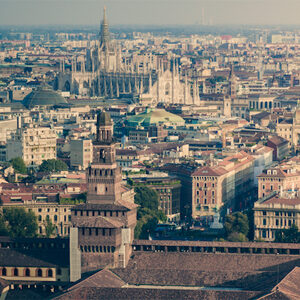 Being the second-largest city in Italy, Milan is one of the major European cities and fashion capital. However, it has a population of over one million people. Therefore, it is not densely populated when compared with other major Italian towns like Rome or Naples.
Being the second-largest city in Italy, Milan is one of the major European cities and fashion capital. However, it has a population of over one million people. Therefore, it is not densely populated when compared with other major Italian towns like Rome or Naples.
History at its best
The central area, including landmarks such as Duomo Cathedral and Galleria Vittorio Emanuele II, has been a UNESCO World Heritage Sites since 1996.
There are many beautiful churches throughout this northern Italy’s region–from medieval churches and structures to modern masterpieces like Basilica di Sant’Ambrogio (a gothic church).
We think you should include some major cities when considering where to live in Italy: Naples, Florence or Rome. But if we had to choose one, we would go with Milan.
Plenty of “to-do” options
Milan also has many green spaces that offer city dwellers all they need for an active lifestyle. Without travelling too far outside the city limits, it’s not difficult to find great running routes and places where one can practice yoga and other exercises.
Or you can also take day trips from Milan into the surrounding countryside to enjoy its natural beauty. Or go to the beach in one of its magnificent coastal towns, such as Riccione.
In Lombardy (the region where central Milan lies), you can enjoy a warm climate for most of the year with hot summers and mild winters. However, it does rain more here than further south. Hence, if you like your sun, there are better places to go – such as southern regions such as Sicily or Sardinia, which offer beautiful beaches too!
Real Estate
Housing options vary greatly, with some being very affordable while others are out of reach for most people on a budget. The median price is around £250,000.
House hunters will find a variety of home styles, from log cabins to traditional villas. With the affordability factor in some areas considered, it is no surprise that Milan attracts residents from all over Italy.
Many big brands and designers have set up shop here. They range from luxury villas in the outskirts of town to modern apartment complexes right downtown.
2. Rome: The capital city with Ancient history
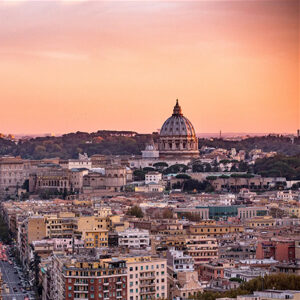 Rome’s city centre, or “Centro Storico”, contains the Roman ruins and remains that give it its global significance as a world heritage site.
Rome’s city centre, or “Centro Storico”, contains the Roman ruins and remains that give it its global significance as a world heritage site.
The most famous part of town is Vatican City, including St Peter’s Basilica, the Sistine Chapel, and other monuments to Christianity. The Colosseum (Coliseum) was an ancient sports arena in Rome where gladiators fought for entertainment during Roman times.
Today there are still many traces left on this ruin because so much happened here throughout time; it will take you hours to explore it all!
Big city life
Many great things about living in a big city and Rome are well known for its ancient “piazzas”, beautiful scenery, and rich culture.
Rome has some of the world’s best restaurants, such as Osteria Della Quercia, which serves great food made with fresh local produce. Pasta al Tartufo (truffle dish) or orecchiette con pepperoni e cozze (small ear-shaped pasta) are some of my favorites.
You can even stroll through one of Rome’s lush parks while enjoying gelato at Cremeria Montebelli located on Via Sistina near Piazza del Popolo.
The public transport around the area is excellent as well. Rome has a large international airport and a train station that connects the city to other parts of the country.
Property prices
The average house price tag in Rome is around £220,000 (about $290,000 US dollars). However, this is the going rate for some of the most popular areas in Rome.
The average house price tag in neighbouring towns like Fiumicino or Castel Gandolfo near Rome is about £180,000 (about $240,000 US dollars).
3. Liguria
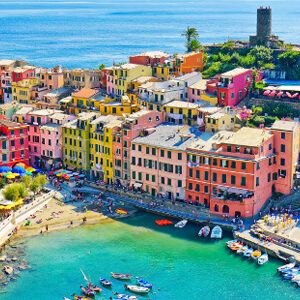 The region of Liguria is in the northwest of Italy. It borders France to the east, and it is close to Nice, which makes it a popular destination for tourists who want to explore both countries on one trip.
The region of Liguria is in the northwest of Italy. It borders France to the east, and it is close to Nice, which makes it a popular destination for tourists who want to explore both countries on one trip.
Liguria has about 600,000 people with 225 different municipalities within its region’s limits, including Cinque Terre, Rapallo and Portofino.
Amenities
Liguria has a lot to offer in terms of amenities. There are a variety of different beaches through its spectacular coastline. They all offer something for people with differing preferences, including long stretches of sand and rocky shores as well as cliff sides to explore.
There are plenty of museums featuring art from the Renaissance era here, such as old masters like Peter Paul Rubens. He was born in Antwerp but studied at the age of 16 when he came to Italy because there were not many schools available back home where he’d grown up.
The city also offers several restaurants, bars, cafes and places where it’s also possible to work from if needed.
Homegrown produce at many markets also make them worth checking out. At the same time, there’s always plenty of seafood available, like sea bass, which is versatile enough to replace meat.
Real Estate prices
The average cost of a house in this area is £280,000 ($330,000).
Gross rental prices are around £7500 ($900) for an apartment and from £450 to £600 per month for houses.
In some cases, it can be possible to rent out properties on the coast or in villages with exciting architecture that tourists have not discovered yet.
This area offers buyers something without equal. If you’re looking for an investment property, this could easily be your best bet.
4. Trento
 Trento is a beautiful city with a lot of classical architecture because Italy’s capital for half a century in the 1700s made it one of the most important cities.
Trento is a beautiful city with a lot of classical architecture because Italy’s capital for half a century in the 1700s made it one of the most important cities.
The people here can be amicable when you get to know them. So this Italian city should not go unmentioned if you’re looking for somewhere new to live!
The temperature in the area is milder than the average in Italy – it’s usually warm weather both during summertime (with highs reaching into the mid-30s) and winter (high tens).
A good offer in terms of amenities
Several things make Trento stand out – such as its classical architecture, friendly locals, and various amenities available in the town (including sporting facilities).
The buildings and squares are an attraction by themselves. Still, Trento also offers plenty to do, including gourmet restaurants with traditional dishes, art galleries, and museums, as well as outdoor activities like hiking or mountain biking just outside town.
The Trento-Mattarello Airport is the city’s airport, which has regular flights to the Italian cities of Milan and Venice, as well as other European destinations.
If you’re moving with your family, this can be a good place as it has plenty of schools, kindergartens and daycare centres with English teachers on hand if needed too.
So there’s not much else that Trento needs to offer in terms of amenities. There are even free sports activities like tennis courts or squash clubs at your disposal so you can keep fit while living here.
Average housing and living costs
The average rent prices are around £450-550/month for a one-bedroom apartment. And when it comes to buying a home, the average cost is around £230 000.
The average monthly cost of living in Trento is about £600-800/month, including your bills, food, and entertainment costs.
You could spend up to £10 on an evening meal out or have one at home for about half the amount. The options are just depending on how much money you want to spend each day.
5. Florence
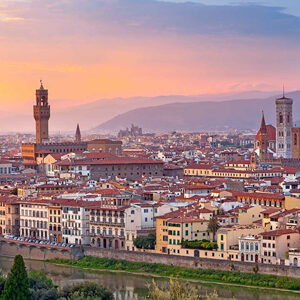 Being the capital city of the Italian region of Tuscany, Florence is the cultural, artistic, and economic centre of the area. It was one of the wealthiest cities in Europe during the Renaissance Era because it had a large flax trade with other parts of Italy.
Being the capital city of the Italian region of Tuscany, Florence is the cultural, artistic, and economic centre of the area. It was one of the wealthiest cities in Europe during the Renaissance Era because it had a large flax trade with other parts of Italy.
Its rich history can still be seen today, from its beautiful churches to world-famous museums like Uffizi Gallery.
The city has been nicknamed “La Bella”, meaning “the Beautiful” by Italians for a good reason. Due to its dry climate, clean air, and mild winters, it is a popular place for expats and tourists looking for an enjoyable experience living abroad–especially due to all the delicious Italian food!
Florence’s central location within Italy makes it easy to access points across Tuscany and the rest of Italy.
The town is home to various universities. It is a major economic hub within Europe and southern Italy.
What can Florence offer you?
Italian culture heavily influences Florence’s art, cuisine, and language. And it has been nicknamed “La Bella”, meaning “the Beautiful” by Italians for several good reasons. Amongst them sits its dry climate, clean air, and mild temperatures making it an attractive place to live abroad, especially for expats looking for a more quiet place than larger cities like Rome or Milan.
The surrounding towns are also popular with tourists who visit during their stay in Florence. They offer some beautiful countryside scenery that can be difficult to find elsewhere on the mainland of Tuscany.
When it comes to families, the town has some great schools that are not too expensive. Still, it can be challenging to enroll children if they don’t speak Italian because they’re very popular with Florentine parents.
As a solution, your best bet is local private school education instead. There’s one international primary school that always comes up as a good recommendation. It’s called the English International School of Florence (EISF). Check their website for more information: http://www.isfitaly.org/.
Life expenses
According to Numbeo’s statistics from 2017, the average monthly rent for an apartment was £700, including utilities. This price can vary depending on where you are looking at renting your home. Still, this number does provide some insight into what the average is around.
This price can vary depending on where you are looking at renting your home. Still, this number does provide some insight into what “average” costs might be like when considering housing prices here in Italy versus other countries around Europe.
Food: One more expense we should mention is food which will cost about £130 – £200 per week, including groceries and eating out – either lunch or dinner most days during the workweek.
If you want to buy property in Florence, you’re looking at an average of £250,000 for a decent-sized property that has at least two bedrooms.
6. Lake Como
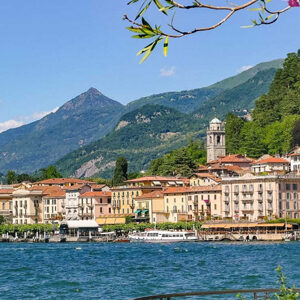 This wonderful town in Northern Italy is perfect for people who want to find themselves in the mountains and look for an easy-going life. With some cultural programs, nature-related activities, or even sports ones.
This wonderful town in Northern Italy is perfect for people who want to find themselves in the mountains and look for an easy-going life. With some cultural programs, nature-related activities, or even sports ones.
Amenities
The place offers many options: it has calm beaches (Lago di Lecco) and wilder shores where you need hiking boots! The lake also includes two islands: Bellagio and Varenna.
It’s possible to see all kinds of architectural styles, from Roman ruins to medieval churches, so this town will satisfy everyone’s architectural tastes regardless of what they’re into.
The city hosts different festivals throughout the year, such as ‘Grignano del Monte’, ‘Vernazza in Jazz’, or the Lake Como Golf Tournament.
Mountains surround the lake, and it’s part of a vast mountainous area that includes many other lakes, which are all worth visiting. If you like skiing, there are two slopes near Lecco: one for beginners (the “Motta” slope) and one for more advanced skiers.
But this is not only a place to enjoy in the winter, but it’s also an excellent destination in summer. Many hotels and resorts on its coasts offer all sorts of water-sports activities like sailing or windsurfing.
All in all, it is one of those places where you can get away from it all. There’s no noise or pollution in this coastal area which has retained much of its original charm. The villages on either side are exceptional too. You’ll find everything from ancient rural settlements to modern cities such as Lenno and Menaggio on the western shoreline, giving Lake Como an unusual variety for a region so close to Milan.
When it comes to schooling, you will find that Lecco and its neighbouring towns (Cernobbio, Borgomanero, and Cusino) provide a good range of options.
Housing prices
Lake Como is well known for its large number of old money inhabitants. Still, it has affordable homes and apartments available for foreigners as well.
This area is more suited toward expats who are either retired or have enough income to live comfortably without working full time. There aren’t many jobs available outside tourism unless you happen to speak Italian fluently. As mentioned before, this city lacks employment opportunities for those seeking long term positions.
The average cost of a house near the lake ranges from £500-800 thousand. That includes a lot of space and plenty of opportunities for relaxation. You’ll find homes with quite large yards, gardens, pools and even vineyards on the property if you’re interested in making wine (the grapes are abundant here).
The prices for apartments near Lake Como start around £200-300 thousand.
FAQ
Where is the safest place to live in Italy?
Trento, Florence, Turin are three big contenders to be the safest places to live in Italy. The other cities on top of the list include Brescia, Padua (Adriatic coast), and Chianti.
If none of those suits your needs, consider some smaller towns like Rovereto or San Marino and new life destinations such as Olbia-Tempio, where property prices are more affordable than anywhere else in southern Calabria.
Where do most expats live in Italy?
The most popular expat hotspots are Rome, Milan, and Venice. All three of these cities offer a wide range of amenities, including museums, shopping centres, and theatres, among many other things.
The coast around central Italy, such as the Amalfi Coast, also attract many foreigners due to their climate. Warmer than places like Florence in winter.
Where is the most affordable place to live in Italy?
The most affordable city to live in Italy is Bolzano-Bozen: it has reasonable prices (£350) while also being very safe, with high-quality schools and hospitals.
The most reasonable prices in Italy are in the north since the south suffers from a lack of public services and infrastructure, making a good quality of life more expensive for residents.
Conclusions
We hope this list has helped you find your perfect home in Italy. In the future, we plan to give more tips for what it’s like living there and how to make sure that moving abroad is a smooth transition.
If you’re interested in learning more about where to live while overseas or want help with any other aspect of planning an international move, check out our other posts at Transport Executive!

